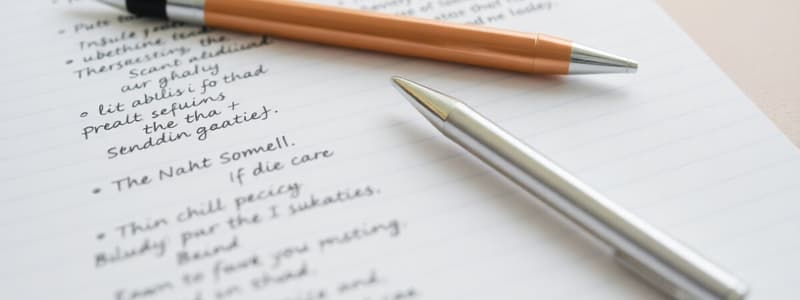Podcast
Questions and Answers
What is the primary goal of study notes?
What is the primary goal of study notes?
- To include as many references as possible
- To summarize information clearly and concisely (correct)
- To provide a personal opinion on the subject
- To create complex and detailed texts
Which is NOT a guideline for organizing study notes?
Which is NOT a guideline for organizing study notes?
- Limiting headers to a maximum of three levels
- Including personal opinions for clarity (correct)
- Using bullet points for organization
- Maintaining clarity and brevity
What technique is suggested for summarizing complex concepts?
What technique is suggested for summarizing complex concepts?
- Using diagrams or charts (correct)
- Creating lengthy paragraphs
- Highlighting irrelevant details
- Employing unnecessary jargon
Which principle should be prioritized in note-taking?
Which principle should be prioritized in note-taking?
What is advised against when creating study notes?
What is advised against when creating study notes?
Which note-taking tool is mentioned as a physical aid?
Which note-taking tool is mentioned as a physical aid?
What should each bullet point in study notes accomplish?
What should each bullet point in study notes accomplish?
What type of reading methods should be employed for effective note-taking?
What type of reading methods should be employed for effective note-taking?
Flashcards
Study Note Format
Study Note Format
Study notes should use a specific format for easy understanding and review, including bullet points and concise language.
Concise Note-Taking
Concise Note-Taking
Study notes must be brief, focused on key concepts, and use clear language, avoiding jargon and excessive details.
Clear Organization
Clear Organization
Study notes should use bullet points for clear organization and easy scanning of information.
Factual Accuracy
Factual Accuracy
Signup and view all the flashcards
Core Concepts Emphasis
Core Concepts Emphasis
Signup and view all the flashcards
Active Reading Methods
Active Reading Methods
Signup and view all the flashcards
Consistent Terminology
Consistent Terminology
Signup and view all the flashcards
Avoid Unnecessary Elaboration
Avoid Unnecessary Elaboration
Signup and view all the flashcards
Study Notes
Instructions for Study Notes
- Study notes should be factual and concise, focusing on key concepts.
- Use bullet points for organization.
- Limit headers to a maximum of three levels.
- Avoid excessive formatting for readability.
- Maintain an objective tone and factual accuracy.
- Avoid references or citations.
- Each point should be understandable independently.
Example Note Structure Demonstrated
- General notes
- Study notes should follow specific format instructions.
- Aim for clear, concise, and well-organized summaries.
- Bullet points offer a concise overview.
- Minimize headers and subheaders.
- Specific Note Example
- Accessible study notes are crucial for effective learning.
- Concise, brief, and organized notes improve readability.
- Avoid unnecessary complexity and extraneous text.
Format Guidelines
- Bullet points ensure clear organization and scannability.
- Information should be easily understood individually and within context.
- Prioritize clarity and brevity for easy comprehension.
- Focus on key facts and concepts.
- Use concise language; avoid jargon.
- Maintain accuracy; avoid fabricating information.
Key Principles for Note-Taking
- Use consistent language and terminology.
- Ensure factual accuracy.
- Focus on core concepts.
- Structure material for efficient learning and review.
- Use a consistent, understandable format for maximum accessibility and learning.
Note-Taking Techniques
- Employ active reading methods.
- Highlight or underline important material.
- Summarize complex concepts.
- Use diagrams or charts to visualize information.
Avoiding Common Mistakes
- Avoid unnecessary elaboration.
- Do not include personal opinions or speculations.
- Avoid embellishments and stylistic additions.
- Maintain factual accuracy.
Note-Taking Tools and Resources
- Highlighters, pens, and notepads are helpful physical tools.
- Digital tools like word processors and note-taking apps can be used to organize notes.
- Digital or physical methods can enhance information retention.
Conclusion
- Well-structured study notes are essential for successful learning.
- Follow the instructions meticulously for accuracy, clarity, conciseness, and factual depth.
- Adhere to the format and guidelines for optimal learning outcomes.
- Diverse note-taking methods exist, and these guidelines offer one approach.
Studying That Suits You
Use AI to generate personalized quizzes and flashcards to suit your learning preferences.
Description
This quiz focuses on the guidelines for crafting effective study notes. It emphasizes the importance of conciseness, factual accuracy, and organization through bullet points. The aim is to create notes that are easy to read and review without additional context.




